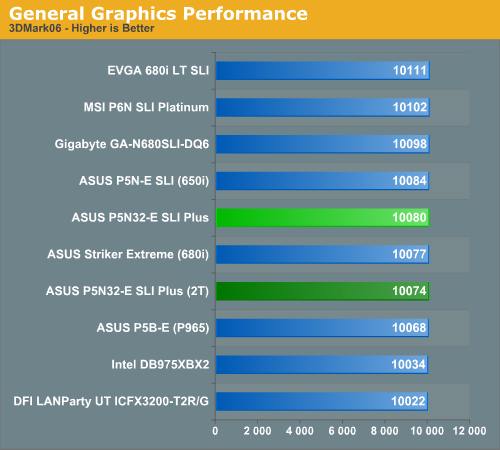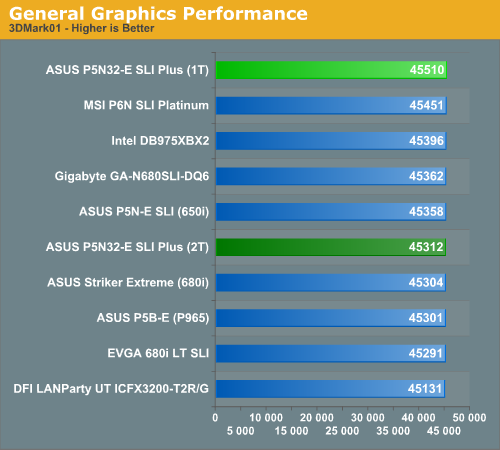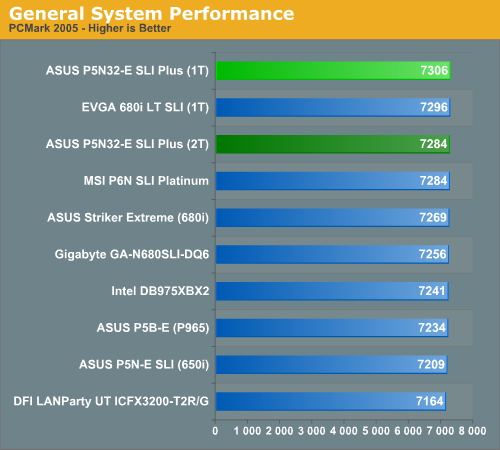ASUS P5N32-E SLI Plus: NVIDIA's 650i goes Dual x16
by Gary Key on April 2, 2007 3:30 AM EST- Posted in
- Motherboards
Synthetic Graphics Performance
The 3DMark series of benchmarks developed and provided by Futuremark are among the most widely used tools for benchmark reporting and comparisons. Although the benchmarks are very useful for providing apple to apple comparisons across a broad array of GPU and CPU configurations they are not a substitute for actual application and gaming benchmarks. In this sense we consider the 3DMark benchmarks to be purely synthetic in nature but still very valuable for providing consistent measurements of performance.


In our 3DMark06 test, all of board are basically even with only an 89 point separation from first to last. Our ASUS P5N32-E SLI Plus board scored in the middle of the pack and offered the best video scores of our test boards but one of the lower CPU scores in this benchmark. While this issue did not repeat itself in our other benchmarks, we still found it strange as the results were opposite with the other 650i SPP based boards.
In the more memory and CPU sensitive 3DMark01 benchmark we see our ASUS Plus board leading all boards with 1T timings and scoring in the middle of the pack with 2T settings. While the differences are not significant, this board does offer excellent benchmark scores when utilizing 1T memory settings.
General System Performance
The PCMark05 benchmark developed and provided by Futuremark was designed for determining overall system performance for the typical home computing user. This tool provides both system and component level benchmarking results utilizing subsets of real world applications or programs. This benchmark is useful for providing comparative results across a broad array of Graphics, CPU, Hard Disk, and Memory configurations along with multithreading results. In this sense we consider the PCMark benchmark to be both synthetic and real world in nature while providing consistency in our benchmark results.

The ASUS P5N32-E SLI Plus board tops our charts in this very competitive benchmark and we are starting to see a pattern emerge with the latest board releases performing slightly better than our boards released last year. The 650i and 680i chipsets scored very well on the single task disk benchmarks with the 680i performing slightly better in the graphics subsystem tests where they led the field. Our 975X and P965 chipset boards won the multitasking tests while the RD600 offered middle of the road performance in most of the tests. Our ASUS Plus board scored better in the multitasking tests than the other NVIDIA boards which propelled it into first place as its graphic scores were only about 1% lower than the 680i LT SLI.
The 3DMark series of benchmarks developed and provided by Futuremark are among the most widely used tools for benchmark reporting and comparisons. Although the benchmarks are very useful for providing apple to apple comparisons across a broad array of GPU and CPU configurations they are not a substitute for actual application and gaming benchmarks. In this sense we consider the 3DMark benchmarks to be purely synthetic in nature but still very valuable for providing consistent measurements of performance.


In our 3DMark06 test, all of board are basically even with only an 89 point separation from first to last. Our ASUS P5N32-E SLI Plus board scored in the middle of the pack and offered the best video scores of our test boards but one of the lower CPU scores in this benchmark. While this issue did not repeat itself in our other benchmarks, we still found it strange as the results were opposite with the other 650i SPP based boards.
In the more memory and CPU sensitive 3DMark01 benchmark we see our ASUS Plus board leading all boards with 1T timings and scoring in the middle of the pack with 2T settings. While the differences are not significant, this board does offer excellent benchmark scores when utilizing 1T memory settings.
General System Performance
The PCMark05 benchmark developed and provided by Futuremark was designed for determining overall system performance for the typical home computing user. This tool provides both system and component level benchmarking results utilizing subsets of real world applications or programs. This benchmark is useful for providing comparative results across a broad array of Graphics, CPU, Hard Disk, and Memory configurations along with multithreading results. In this sense we consider the PCMark benchmark to be both synthetic and real world in nature while providing consistency in our benchmark results.

The ASUS P5N32-E SLI Plus board tops our charts in this very competitive benchmark and we are starting to see a pattern emerge with the latest board releases performing slightly better than our boards released last year. The 650i and 680i chipsets scored very well on the single task disk benchmarks with the 680i performing slightly better in the graphics subsystem tests where they led the field. Our 975X and P965 chipset boards won the multitasking tests while the RD600 offered middle of the road performance in most of the tests. Our ASUS Plus board scored better in the multitasking tests than the other NVIDIA boards which propelled it into first place as its graphic scores were only about 1% lower than the 680i LT SLI.










37 Comments
View All Comments
R3MF - Monday, April 2, 2007 - link
this mish-mash of different chipsets probably works fine under windows, because asus will provided a tailored nVidia driver to ensure it works.but they have always been rubbish at providing a linux variant of the proprietary systems design.
can i use the standard release nVidia linux chipset drivers to use this board under linux?
if the answer is 'no' then this board is garbage.
Gary Key - Monday, April 2, 2007 - link
This board uses the standard NVIDIA 680i driver set in XP and Vista. I had no issues loading SUSE 10.2 on the board but did not test it extensively with RAID or other options. The ADI audio worked but not as well as the Realtek offerings on other boards.yacoub - Monday, April 2, 2007 - link
but only for you and the other handful of folks in that situation...yyrkoon - Monday, April 2, 2007 - link
Yes, and no. Because users are fed up with MS/WIndows/Vista, a lot of users are making the plunge into Linux.Anyhow, it is the softwares responcability to comply with the hardware, not vice versa(to a point that is, obviously the hardware does need to comply with each specification, IE SATA, IDE, x86, etc.), if Linux is to be taken seriously, the Linux dev teams NEED to write a module for every possible chipset out there . . . if not, then well, you will have what you currently have right now, an OS, that does not support near as many hardware configurations, as Windows does.
Linux is a fun OS, and great for certain situations, but when you have problems like those caused by udev, and whatever else, you can not help but feel like it is not complete. Granted, the Linux dev teams for each distro, is usually much smaller than the teams that write code for Windows. End results however, tend to make this user feel as though Linux is a toy OS, with lots of work still needed. Ubuntu, is good for some situations, and a cutting edge Distro such as SabayonLinux, is also not without its quirks(but 'feels' very simular to Windows Vista.).
The end result is: what do *you* expect from a free OS ? Personaly, I like each, for different reasons, but still consider Windows to be the only real serious OS, mainly because of support for many, if not nearly all forms of hardware. Look and feel also are a consideration, but Linux has been closing the gap here, for a long time now.
Anyhow, that 'handful of users' is growing day by day, and is not really a 'handful' any more.
MrWizard6600 - Monday, April 2, 2007 - link
I could really use to see one. I don't see the differances between this board and a regualar 680i chipset, aside from the northbridges being different (which you would think would impact total PCI-e lanes but... apparently not..).so can you put together a map?
sWORDs - Tuesday, April 3, 2007 - link
Check this post, it's a dutch forum, but the first second and third table are english, and those are the ones you need.http://gathering.tweakers.net/forum/list_messages/...">http://gathering.tweakers.net/forum/list_messages/...
Gary Key - Monday, April 2, 2007 - link
Let me see what we can create tomorrow.